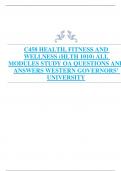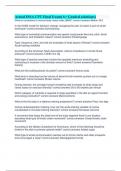C458 HEALTH, FITNESS AND
WELLNESS (HLTH 1010) ALL
MODULES STUDY OA QUESTIONS AND
ANSWERS WESTERN GOVERNORS’
UNIVERSITY
,C458 Health, Fitness, and Wellness Study Questions
Unit 1: Physical Health
Unit 1—Module 1: Body Systems
1. Define the key structures found in the skeletal system.
a. Bones: provide the internal framework the body needs to stand. There are 4
classifications of bones: long bones, short bones, flat bones, and irregular bones.
b. Joints: Where bones come together. They are classified in 3 ways, immovable, slightly
movable, and freely movable.
c. Cartilage: Tough but flexible tissue that covers the end of bones of freely movable joints
and protects bone from them rubbing against each other. It also gives shape and support
to other parts of the body.
d. Ligaments: Is a connective tissue that binds the bone to another. It usually helps hold
structures together and allows for side-to-side stability.
e. Tendons: A connective tissue that attaches the muscle to bone. It aides in the movement
of the bone or structure.
2. Name the three types of muscle found in the body.
a. Striated muscle- moves all bones and controls facial expressions and eye movements.
b. Smooth muscle- lines the walls of internal organs.
c. Cardiac muscle- only in the heart and is a combination of both striated and smooth
muscles.
3. Define the two main divisions of the nervous system:
a. Central nervous system: Nerves inside the brain and spinal cord that sends signals to
other parts of the body.
b. Peripheral nervous system: All nerves outside of the brain and spinal cord.
4. Define the key structures and organs associated with the respiratory system.
a. Lungs: They exchange gases (oxygen and carbon dioxide) during breathing.
b. Respiratory Passages: Are divided into the upper and lower tract. The upper includes the
nose, pharynx (throat), and larynx (voice box). The lower includes the trachea
(windpipe), bronchial tree, and lungs.
5. Define the structures of the upper respiratory tract and the lower respiratory tract.
Page 1 of 42
,C458 Health, Fitness, and Wellness Study Questions
a. The upper includes the nose, pharynx (throat), and larynx (voice box). The lower
includes the trachea (windpipe), bronchial tree, and lungs.
6. Describe the main structures of the cardiovascular system.
a. Heart and blood vessels. The heart is a pump that consists of four chambers, two uppers
called atria and two lowers called ventricles.
7. Trace the pathway of blood through the heart.
a. Oxygenated blood enters into the left side of the heart, which pumps it out of the heart
through the aorta. The arteries and capillaries deliver the oxygenated blood cells to the
organs.
8. Describe the main organs of the digestive system.
a. Mouth- Food is ingested in the mouth where it is broken down by teeth and saliva.
b. Esophagus- Once food is swallowed, it goes down the esophagus, which is a tube about
9 to 10 inches long that connects to the stomach.
c. Stomach- The stomach helps digest food by mixing it with digestive juices and churning
it into a thin liquid.
d. Small intestines- As the partially digested food moves out of the stomach it enters the
small intestines. Absorption of nutrients into the bloodstream occurs here.
e. Large intestines- The undigested food and fluids exit the small intestines and enters the
large intestines. Water, some nutrients, and electrolytes are removed to form a
concentrated, solid feces. (stool)
f. Anus- The stool passes from the large intestines into the rectum where it is stored. It is
eliminated from the body through the anus.
9. Describe the major organs of the urinary system.
a. Kidneys- Responsible for producing urine.
b. Ureter- A tube attached to the kidneys through which urine passes from the kidneys to
the bladder.
c. Bladder- T temporary hold reservoir for urine. Once full, the body has the urge to
urinate.
d. Urethra- A tube connected to the bladder, in which urine is expelled from the body.
10. Discuss the role of the immune system and its major organs and structures.
a. Is a complex network of cells, tissues, and organs that work together to defend and
protect the body from foreign invaders that can cause sickness and disease.
Page 2 of 42
, C458 Health, Fitness, and Wellness Study Questions
b. Lymph, Lymph nodes, bone marrow, tonsils, adenoids, spleen, and thymus gland.
c. White blood cells find and destroy bacteria, viruses, parasites, fungi, and substances that
appear harmful and foreign.
11. Describe the structure and function of the integumentary system.
a. Hair, skin, nails, and associated fluids secreted by glands make up the system.
b. Hair and nails have sensory receptors. Hair keeps body warm, nails protect the fingertips
and toes for injuries to the surround soft tissue.
c. Lubrication- The skin contains two types of glands that produce important secretions.
Sebum and sweat. Sebum is an oily substance that does not let the skin dry out. Sweat
helps the body cool down.
12. Discuss the role of the endocrine system.
a. Send chemical messages called hormones. It influences growth, development, and
energy-producing activities.
b. Keeps the body in overall homeostasis.
c. 8 major glands that secrete hormones: Pineal, pituitary gland, thyroid, thymus, adrenals,
pancreas, and the ovaries or testes.
13. Describe the function of the reproductive system and name its main organs and structures.
a. Female Internal- Uterus- where the fetus develops during pregnancy. Ovaries- Where
the eggs are produced. Fallopian tube- Where the egg is fertilized. Cervix- opens during
childbirth for the baby to pass through. Uterus- sheds during menstruation.
b. Female External- Labia- A set of lips that surround and protect the vagina. Vagina- A
collapsible tube that connects to the uterus and cervix to the outside of the body.
Urethra- Where urine is expelled from the body. Clitoris- A small organ composed of
erectile tissue, similar to the penis.
c. Male- Testicle- produces sperm. Scrotum- The sac that encloses the testes on the
outside of the male body. Prostate- Gland in the male repo system that helps make
semen, the fluid that contains sperm. Vas Deferens- A duct that carries the sperm up
into the pelvic region, leading toward the urethra. Urethra- Where urine is expelled from
the body. Penis- A male erectile organ by which urine and sperm are discharged from
the body.
Unit 1—Module 2: Diseases
1. Name and state the symptoms of common communicable diseases. Briefly describe prevention
and treatment strategies.
Page 3 of 42





